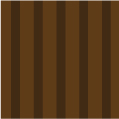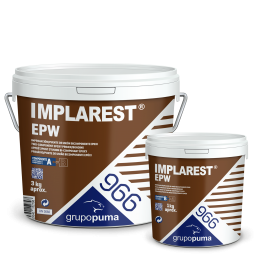 Implarest® EPW
Implarest® EPW

Two-component water-based epoxy primer/ bonding bridge for preparing damp and dry surfaces.
Additional information
Composition
Product based on epoxy resin and a polyamine hardener.
Features and applications
- Specially designed to increase adherence and improve the flatness of the substrates where MORCEM® ELASTIC PM and MORCEM® ELASTIC POLIUREA, a single-component polyurethane membrane, are to be applied.
- For application on non-porous substrates such as ceramics, metals, wood, asphalt, PVC or asphalt sheets.
- It can also be applied on porous substrates such as concrete or mortar. It is a mixture of two water-based epoxy products. It requires a smooth, clean, dry and as hard as possible substrate.
- It is CE marked as it used under the MORCEM® COVER waterproofing systems, polyurethane membrane and polyurea membrane, under the ETAG 005 guide.
NOTE: consult our technical department for application on other types of substrates or situations.
Substrates
- Applicable on non-porous substrates: ceramics, metals (pre-painted steel, zinc, copper, galvanised steel...), PVC or asphalt sheets. It can also be applied on porous substrates. It can be diluted with water (maximum 20 %) to facilitate its spreading on the substrate, taking into account the water that may already exist on the substrate.
- Its use as a primer depends on the situation of the substrate, irregularities or flatness level, it may vary between 100-300 g/m² in several coats.
- It can be applied by roller, brush or airless spraying equipment.
- It can be applied on substrates with an existing substrate humidity of max. 10 %.
- Do not apply on substrates with humidity or existing water coming from the inside of the substrate (water pressure due to water table, filtrations...).
- It can be applied in combination with mineral fillers (silica aggregate) on very irregular substrates.
Instructions for use
- The surface must be clean and dry. If necessary, use pressurised water to remove oil, grease, efflorescence and other contaminants, as well as poorly adhered cement slurry.
- In some cases, it is necessary to use mechanical procedures for this specific preparation of the substrate, as well as chemical procedures for cleaning metal surfaces.
- Dilute component A with water (max. 20%), in case of non-porous substrates to apply a thin film, or to facilitate spreading in case of rough substrates.
- Mix both components by mechanical stirring for about 2-3 minutes.
- In any case, check the homogeneity of the mixture.
- Take this residual cleaning moisture into account when carrying out the application, i.e., wait until it has evaporated completely or use measuring equipment to assess its presence in the substrate.
- Apply IMPLAREST EPW in two or more coats until the desired flatness is achieved.
- If the substrate is very uneven, a first coat of IMPLAREST EPW mixed with mineral fillers can be applied to even it out.
- Wait until its drying time has elapsed before continuing with the application of the waterproofing, or re-application of the same product.
Cautions and recommendations
- Do not mix at temperatures below + 8ºC and not above +35ºC.
- Epoxy-based product that may irritate the skin, so it is recommended to use it always with gloves, safety goggles and safety overalls.
- Tools and implements shall be cleaned with solvent immediately after use to avoid hardening of the material, which will have to be removed mechanically.
- Mix well before use.
- Consult the Technical Department for any application not specified in this Technical Data Sheet.
- For all information regarding the safe handling, transport, storage and use of the product, refer to the label and the current version of the Material Safety Data Sheet.
Packaging
Metal packaging kits with the following formats:
- BIG KIT: 15 kg+5 kg
- SMALL KIT: 3 kg+1 kg
12 months at a temperature between 5ºC and 35ºC in dry locations.
If the package is opened, it must be used immediately.
Technical data
| Finished product density at 23ºC ISO 1675 | 1 g/cm3 |
| Density component A at 23ºC ISO 1675 | 1,022 g/cm3 |
| Density component B at 23ºC ISO 1675 | 1,053 g/cm |
| Viscosity at 23ºC ISO 2555 | 3,500 cps |
| Percentage of the mixture | 3:1 |
| Adhesion to concrete | >2 N/mm2 (MPa) |
| ISO 1768 Solids content | 55% |
| VOCs (volatile organic compounds) | 3.8 g/l |
| Pot life at 23ºC | 60-90 minutes |
| Initial drying at 23ºC | 5-6 hours |
| Final drying at 23ºC | 7 days |
| Recoating range at 23ºC | 6-48 hours |
| Room temperature / substrate | 3-35ºC |
| Maximum substrate humidity | 10% |
| Dilution (in water) | maximum 20%. |
The values in this table are approximate and may vary according to the situation of the substrate or the application methodology used.
Note
The instructions for use are given according to our tests and knowledge and do not imply any commitment by GRUPO PUMA nor free the consumer from the examination and verification of the products for their correct use. Claims must be accompanied by the original packaging to allow a proper traceability.
GRUPO PUMA is not responsible, in any case, for the application of its products or constructive solutions carried out by the application company or other parties involved in the process and / or execution of the work, limiting the responsibility of GRUPO PUMA exclusively to the damages directly attributable to the supplied products, individually or integrated in systems, due to failures in their manufacturing process.
In any case, the drafter of the work project, the technical management or the person responsible for the work, or collaterally the application company or other parties involved in the process and / or execution of the work, must ensure the suitability of the products addressing the characteristics of them, as well as the conditions, support and possible pathologies of the work in question.
The values obtained by GRUPO PUMAS's products or its constructive solutions that, as the case may be, are determined by the EN standards or any other regulation that applies to it in each case refers exclusively to the conditions specifically stipulated in said regulation and that are referred to, among others, to certain characteristics of the support, humidity and temperature conditions, etc. without being them required in the tests obtained under different conditions, all in accordance with the relevant regulation.
GRUPO PUMA is not responsible, in any case, for the application of its products or constructive solutions carried out by the application company or other parties involved in the process and / or execution of the work, limiting the responsibility of GRUPO PUMA exclusively to the damages directly attributable to the supplied products, individually or integrated in systems, due to failures in their manufacturing process.
In any case, the drafter of the work project, the technical management or the person responsible for the work, or collaterally the application company or other parties involved in the process and / or execution of the work, must ensure the suitability of the products addressing the characteristics of them, as well as the conditions, support and possible pathologies of the work in question.
The values obtained by GRUPO PUMAS's products or its constructive solutions that, as the case may be, are determined by the EN standards or any other regulation that applies to it in each case refers exclusively to the conditions specifically stipulated in said regulation and that are referred to, among others, to certain characteristics of the support, humidity and temperature conditions, etc. without being them required in the tests obtained under different conditions, all in accordance with the relevant regulation.